We return to Pegasus, but this time with a telescope to find a grab-bag of overlooked deep-sky treasures.
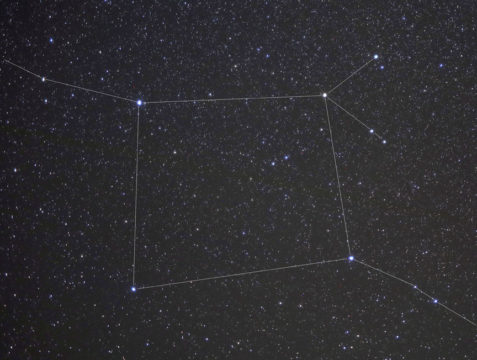
Bob King
Last month we gazed into the Great Square of Pegasus to determine the faintest stars we could glimpse without optical aid. Now, let's set up our telescopes for a deeper look.
I admit that I'm guilty of passing right over the Great Square on my way to brighter fare, but deep-sky treasures abound here for owners of 8-inch or larger scopes.
So, I hauled my 15-inch reflector out to the countryside on several nights, and enjoyed a host of bright and faint galaxies, galaxy groups, and a curious "dissolving" open cluster — all located within the confines of the Great Square. At the end of each session I felt a delicious sensation of being far from home, exploring hitherto unknown destinations. Ever since I was a boy, I've loved exploring new places. Maybe that's why astronomy still has such a powerful grip on me — the territory is endless.
You'll find my observations below, but I encourage you to step into the heavenly quadrangle with your own scope. I think you'll be amazed at what you've been missing.
Getting Started
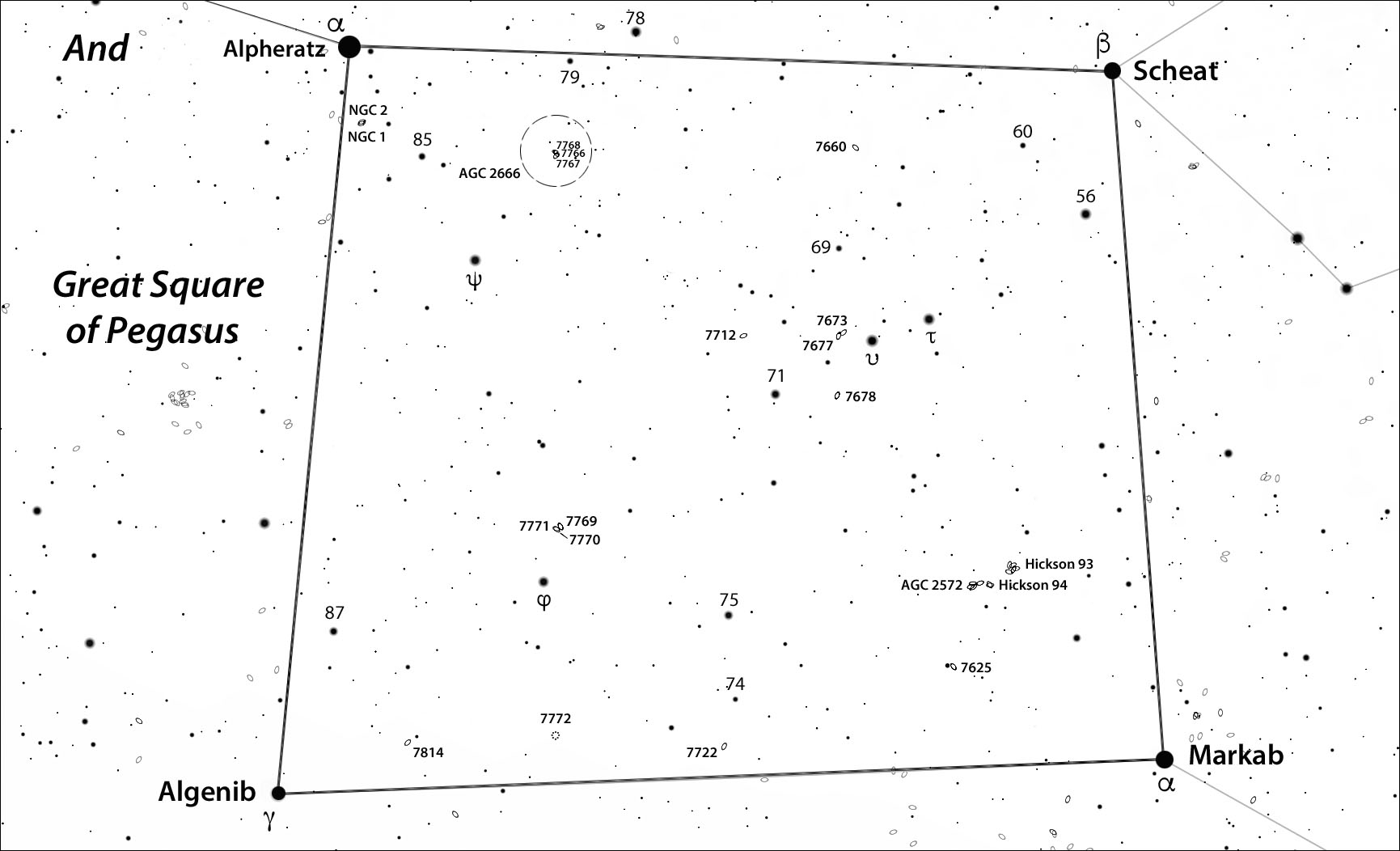
Stellarium with additions by the author
For best results with any faint galaxy group, start at low magnification to get oriented, then increase the power to 200× or more. This will not only darken the sky and improve contrast, but also make the galaxies big enough to catch the attention of your eye. Granted, high magnification usually softens the image, but that's a small price to pay to improve your chances of seeing your target. One additional caveat: take the magnitude figures given here with a grain of salt. For many galaxies only blue or photographic magnitudes are available. These are often a full magnitude fainter than visible-light values.
Tight Galaxy Group Hickson 93
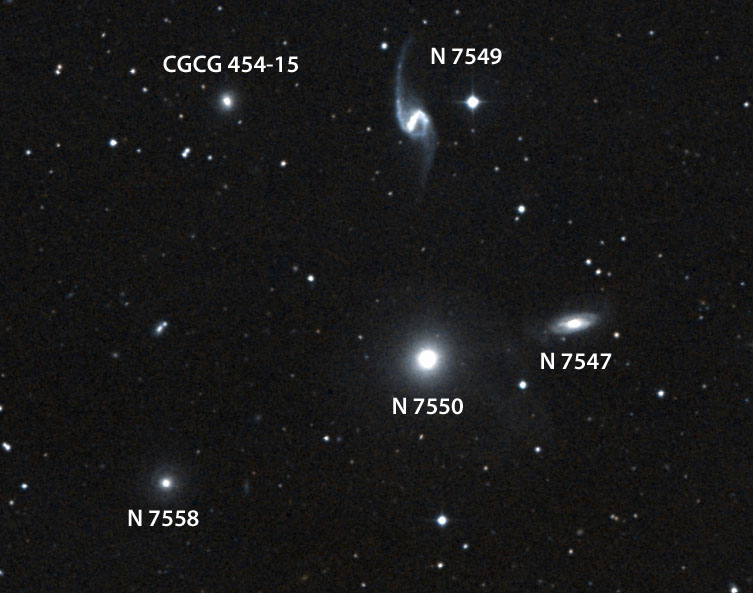
Aladin Sky Atlas
Let's begin with Hickson 93, a tight galaxy group dominated by 12th-magnitude elliptical NGC 7550. This galaxy registers in my scope as a dense, round patch of haze about 1′ across and punctuated with a stellar nucleus. I spotted it straight off in my lowest magnification eyepiece (64×), then sought out its fainter neighbors — the photographically magnificent barred spiral NGC 7549, which is a faint (magnitude 13.2) north-south elongated puff, and NGC 7547. Because it's small (0.4′) and condensed, the latter appeared more obvious despite being fainter (magnitude 13.6). NGC 7558, located a couple arc-minutes east of NGC 7550, was a mere spot of light that flickered in and out of view even with averted vision. I had no luck with CGCG 454-15, the field's fifth, and faintest member.
Seven Faint Galaxies in Hickon 94
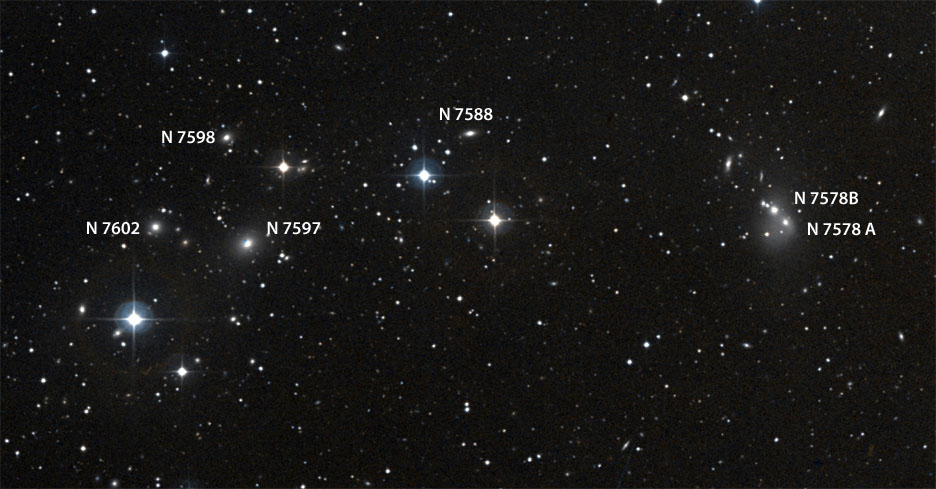
DSS2 / Aladin Sky Atlas
Just ½° southeast of Hickson 93 you'll find Hickson 94 (also known as Arp 170), an extremely compact group of seven faint galaxies strung out on a 3.5'-long northeast-southwest line. After rolling my observing eye to the right spot, I could only make out two faint, foggy bits nearly in contact. These are the small galaxies NGC 7578 A (magnitude 14.3) and NGC 7578B (magnitude 15.0). The "A" galaxy is 1′ long and punctuated with a star-like nucleus, while "B" is slightly smaller, spanning only 0.6′.
Neighboring Abell 2572
If you nudge your scope 15′ east you'll arrive at the center of Abell 2572. Recent research has shown that neighboring Hickson 94 is actually the compact core of a true galaxy cluster, while Abell 2572 (the supposed cluster) should in fact be classified as a galaxy group — a smaller, sparser collection of galaxies. In the distant future, the distinction will be moot because the two bunches are speeding toward one another at 1,000 kilometers per second and appear destined for a merger.
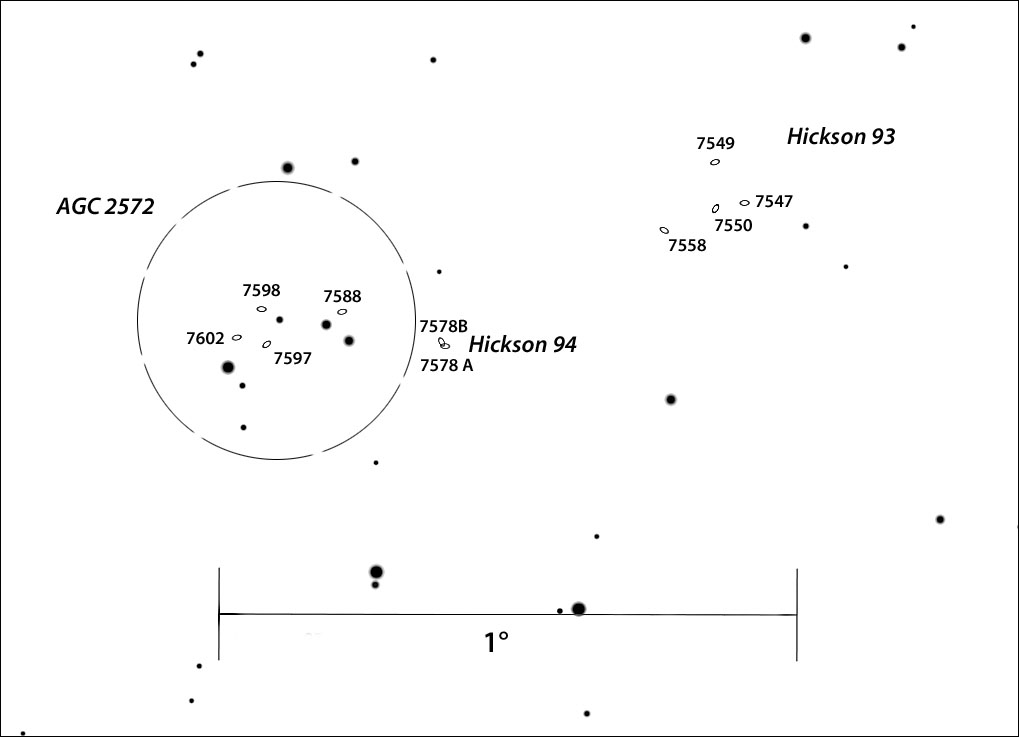
Stellarium with additions by the author
A handful of 8th- and 9th-magnitude stars distract from the faint quarry comprising Abell 2572. However, I could make out several galaxies, including NGC 7597. At roughly magnitude 13.5, it's the group's brightest member and is notable for its compact, bright core. I also glimpsed NGC 7602 and 7598, both of which are very faint and small with diameters of around 15" to 20″. Use the detailed finder chart above to navigate this rich area.
Spiral and Lenticular Galaxies
Ready for something brighter? Drop 1.5° south of Abell 2572 to NGC 7625, a compact spiral galaxy located a few arc-minutes due west of a 9th magnitude star. With a diameter of 1.6′ and glowing at magnitude 11.8, it's easy to spot at low magnification, as an east-west elongated patch of fuzz with a denser, brighter core and faint, star-like nucleus.
From here, scooch your scope roughly 3.5° east-southeast to meet up with NGC 7722, a 12.4-magnitude, 2′ wide lenticular galaxy. It's located 1′ south of a 12.5-magnitude star, and about as off-the-beaten path as they come. Using 245×, I discerned a faint twinkle of a nucleus within the galaxy's dense, bright core.
Remnant Open Cluster NGC 7772
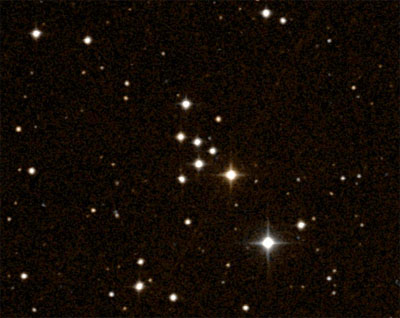
DSS2 / Aladin Sky Atlas
Next in line — 2.5° farther east — we arrive at the open cluster NGC 7772, which seems strangely out of place hobnobbing with remote galaxies and far from the band of the Milky Way. This stellar collection is 4,900 light-years away, and roughly 1.5 billion years old — ancient for an object of this type. A 2002 study suggests NGC 7772 is a remnant cluster, a stellar family robbed of its smaller suns due to gravitational dynamics within and without the group.
At 64× the cluster is a bright stand-out in a sparse field and boasts about 10 stars shining between magnitude 9 and 14. In the heart of the cluster, I spied a delightful V-shape pattern that reminded me of a mini-Hyades. British astronomer John Herschel first found his way to NGC 7772 on Oct. 7, 1825. Share in that discovery when you make your way here the next clear night.
Bright Galaxy NGC 7814
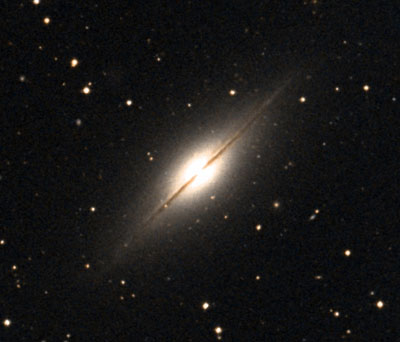
DSS2 / Aladin Sky Atlas
Continue trekking east another 2.4° to arrive at one of the brightest galaxies in our survey, magnitude 11.6 spiral NGC 7814. In photographs, the dark bar of galactic dust bisecting its glowing halo makes it look like a miniature version of M104, Virgo's famous Sombrero Galaxy.
NGC 7814 immediately popped into view at 64×, aided by a 7th magnitude star 2′ northwest. Nice and beefy at 5.5′ × 2.3′, I saw a substantial oval glow elongated northwest-southeast with dense inner disk and bright, non-stellar core. With averted vision, a fainter outer disk flashed in and out of view but, alas, no equatorial slice of dust was revealed. However, if you have a larger scope, you might succeed capturing this prize.
Galactic Triplet
Next, we turn north to a cozy galactic triplet that easily squeezes into a high-power field of view. NGC 7769 and NGC 7771 are both 12th magnitude spirals, about 2′ apart. The former is round with a bright, compact center, while NGC 7771 is strongly elongated east-west with a star-like nucleus. NGC 7770, located immediately southwest of NGC 7771, looked at first like a 13.5-magnitude star, but high magnification revealed a dense, fuzzy dab of light no more than 20″ across. Seeing it morph from a "star" into a galaxy was one of the night's best surprises. NGC 7770 is a lenticular galaxy with a double nucleus oriented east-west. On nights of excellent seeing, crank up the magnification and you might just see the duo.
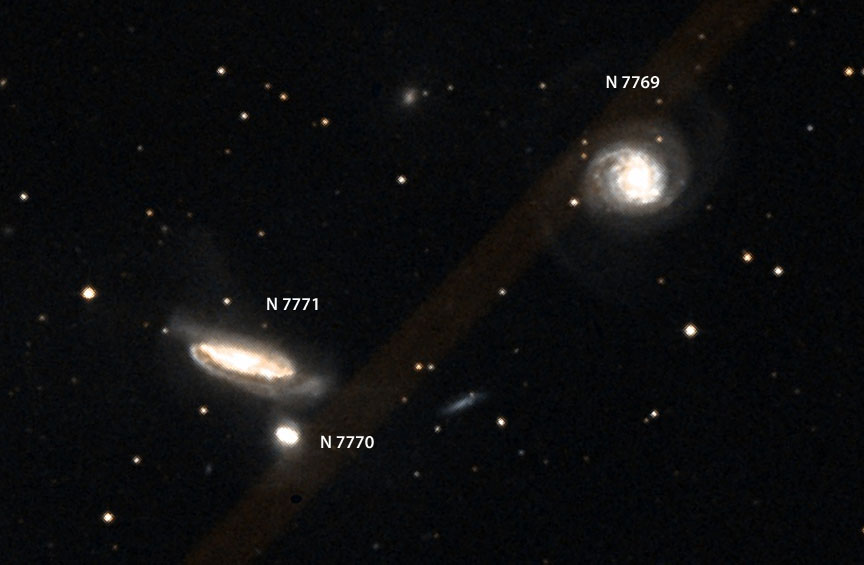
DSS2 / Aladin Sky Atlas
Tiny Elliptical NGC 7660
Like eating corn-on-the-cob row by row, let's return to the western edge of the Square (and the chart at the top of the page) to work our way east for a second time, starting with NGC 7660. This is a tiny, but conspicuous, elliptical galaxy appearing only 20″ across (officially 1.4′ x 1.0′) but at magnitude 12 is fairly bright and features a prominent inner core with a stand-out stellar nucleus. Look 3.3° to the south for a pretty pair of 13th magnitude spiral galaxies, NGC 7673 and NGC 7677, separated by about 6′ and each spanning about 1′. The former has a dense disk with a somewhat brighter center but no obvious nucleus. Its fainter neighbor, NGC 7677, is elongated northeast-southwest with a bright near-stellar core set in a faint disk.
Face-on Spiral NGC 7678
NGC 7678 (also cataloged as Arp 28) is a 12.7-magnitude, face-on spiral galaxy caged within a small triangle of 12th-magnitude stars. The spiral appeared round, diffuse, and about 1.5′ across, with a vaguely brighter extended core and star-like nucleus. Using 245×, I detected a mottled texture indicating the galaxy's prominent spiral arms, which show well in photos. NGC 7712 is a faint, 13th-magnitude misty glow about 45″ across and slightly condensed toward its core.
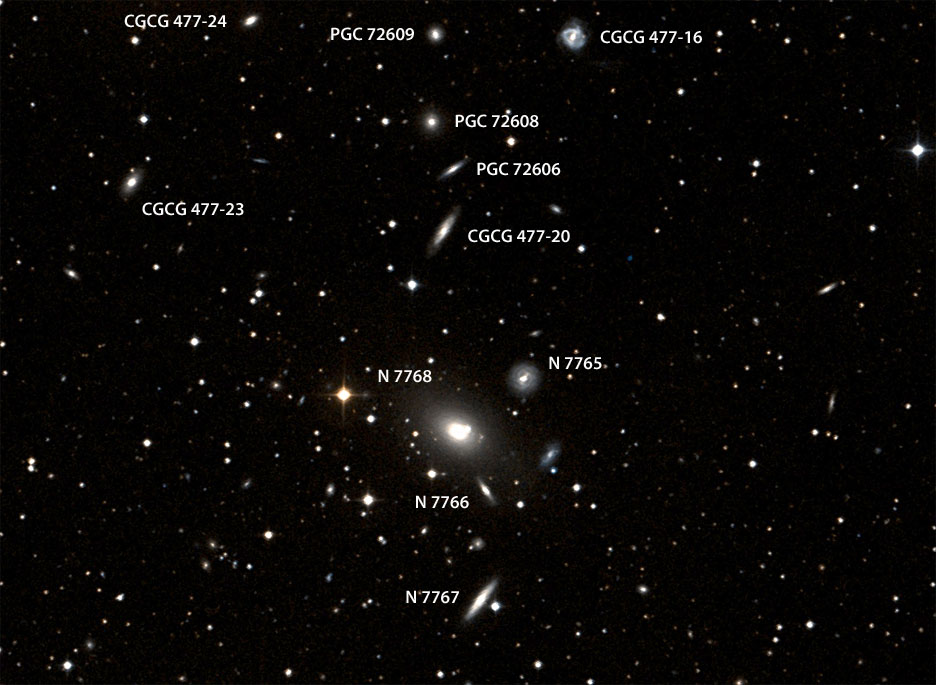
DSS2 / Aladin Sky Atlas
Giant Elliptical NGC 7768
Situated near the south end of a remarkable north-south chain of galaxies we find NGC 7768, a 12th magnitude giant elliptical galaxy that dominates galaxy cluster Abell 2666, which is located 340 million light-years from your front door. Using 245×, I also fished out two, very faint additional galaxies, NGC 7766 and NGC 7767, south of NGC 7768.
Thing 1 and Thing 2
We finish our tour near Alpheratz (α Andromedae) in the square's northeastern corner where the NGC numbers transitions from the high 7,000s, back to 1. The crossover occurs at 0h right ascension. So, what better way to wrap up our intergalactic adventure than by returning to square one? NGC 1, that is. As it happens NGC 1 is paired with NGC 2, located just 1.5′ to the south. The duo form one of the best two-for-one specials in the night sky.
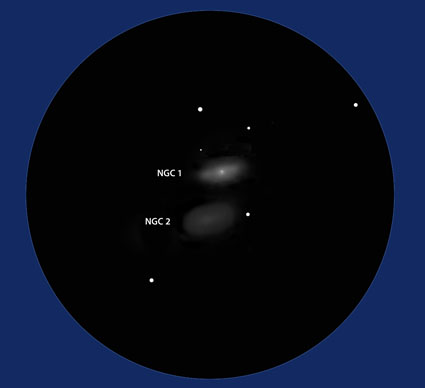
Bob King
Using 245×, NGC 1 showed as a neat 1.5′ disk extended east-west with a bright, nearly stellar core that stood in direct contrast to the faint, foggy appearance of NGC 2. Although the two objects look as though they're related, they actually aren't. NGC 1 lies in the foreground at a distance of about 210 million light-years, while its "companion" lurks 350 million light-years away. Both are spiral galaxies, with NGC 1 similar in size to our Milky Way. It was discovered by German astronomer Heinrich d'Arrest in 1861, and now waits for you to rediscover it.
There are far more galaxies inside the Great Square. I chose a modest sample. Whether you find one or 20, my hope is that you to lose yourself in the vastness of the universe for a couple of hours.
 5
5









Comments
tannaz
January 19, 2020 at 5:29 am
terrific !!!
You must be logged in to post a comment.
Bob KingPost Author
January 21, 2020 at 11:00 am
Thank you, tannaz 🙂
You must be logged in to post a comment.
Tom Kellogg
October 29, 2021 at 2:42 pm
Bob, I took a look at NGC 7768 with a 30" telescope last night and look at the description on Sky Safari Pro which says it's diameter is 169,274 light years. That is quite a difference from 5 million LY as you state in this article. Perhaps you meant to say that the galaxy cluster is 5 million LY across. Which is correct?
You must be logged in to post a comment.
Bob KingPost Author
October 29, 2021 at 3:23 pm
Hi Tom,
Thank you for pointing out the error. The number I used referred to the frame size. Indeed the galaxy is about 175,000 light-years across.
You must be logged in to post a comment.
Tom Kellogg
October 29, 2021 at 5:50 pm
Thanks Bob. I greatly appreciate you including distances to celestial objects in your articles. I wish all articles in S&T would always included distances to objects, even when we all know that the distance may actually be a few times further or closer. A central fact in my appreciation of the little smudges in my telescope views is knowing the distances.
A regular fan of your contributions to S&T and to my knowledge of our home universe.
You must be logged in to post a comment.
You must be logged in to post a comment.